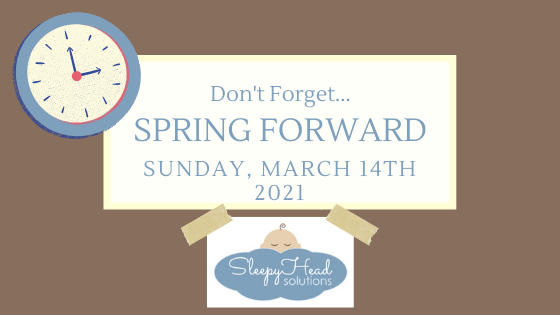It’s hard to believe an entire year has passed since the start of Daylight Saving Time (DST). So much and so little has happened in the last 12 months. I hope you and your family have stayed healthy and sane and are looking forward to better times.
The start of DST brings the comfort of knowing that spring is just around the corner. This year, spring cannot come a minute too soon! On Sunday, March 14th, we will move our clocks forward one hour. The good news is that “springing forward” is almost always less problematic for our little ones than “falling back,” when Daylight Saving Time ends. With this time change, some lucky parents may even be able to get their early risers to wake a bit later in the morning.
Before your bedtime on Saturday night, turn your clocks ahead by one hour. If your child usually sleeps until 6:00 am, the next morning she will, most likely, sleep until 7:00 am. For those of you who have early risers, you can use this time change to your advantage to help your little one get on a later schedule. Her entire day will shift an hour later (naps, bedtime, meals, etc.). Don’t forget to adjust your toddler’s OK to Wake clocks so they don’t get up earlier than necessary!
If the later wake time works in your favor, then you do not need to do much to change your little one’s schedule. With the sun rising earlier in the morning be sure to use…
- Room darkening or blackout shades to keep out any early morning sunlight that may creep through (black garbage bags taped to the windows work well, too).
- A sound machine used on the white noise setting help muffle outside noises such as barking dogs and early morning birds that may be waking your little one.
If your child needs some help to get back to her regular schedule, try these suggestions:
- On Saturday night, put your child down for the night at her regular time.
- On Sunday, wake your child at the time that she normally wakes (6, 6:30, 7 am) according to the new time.
- If your little one is still napping, nap her at her regular nap times according to the new clock. If your baby is more sensitive to schedule changes you can start the naps 30 minutes earlier than usual (according to the new time) and gradually, over the next several days, extend the beginning of the nap to the regular start time.
- On Sunday night, put her down at her regular bedtime (according to the new time).
- Continue with her well-established schedule according to the new time (same wake times, nap times, bedtimes, and feeding times).
Be sure to expose your child to lots of natural light throughout the day, and continue with all of your normal activities to help reset her internal clock to the new time.
Just because it is light outside later into the evening, avoid letting your little one’s bedtime drift later by making sure to put her to bed at the time she needs. An overtired child leads to difficulty falling asleep, more nighttime wakings, and early wakings in the morning. A well-rested child leads to a happier child and a happier mom and dad!
However, you decide to handle the start of Daylight Saving Time, be patient with yourself and your child. Keep in mind that it may take up to a week for your little one to adjust.
